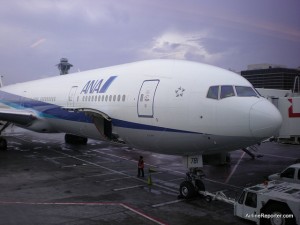
ANA Boeing 777-300ER (JA781A) at Narita after my 11hr flight from LAX.
Flying in any airline’s Business Class is always a nice treat. There are some airlines with pretty decent domestic Business Classes out there, but to really have a top-notch experience, you need to take an international flight. Recently, when I flew from Los Angeles (LAX) to Narita Airport (NRT) in Japan, I was able to fly in All Nippon Airway’s (ANA) Business Class (disclaimer: ANA picked up the tab on my flight from LAX-NRT-LAX).
The benefits of flying in a premium seat starts at the airport. After arriving at LAX from Seattle I checked in for ANA and then it was time to hit security. Having a premium seat meant I was able to use the express TSA line. It wasn’t too much of a benefit for this flight since the express line only had two people in it, and the normal line had five — oh well.
After taking off my shoes and having my toothpaste scanned, I headed right to ANA’s Business Lounge. Unfortunately due to a bunch of construction going on at LAX, the view wasn’t the best, but I was able to watch a Qantas Airbus A380 get towed, so I was happy. There was plenty of space, free wi-fi and all the amenities you would expect to find in a Business Class lounge. This was good, since I had a nice 3.5hr layover in LAX.
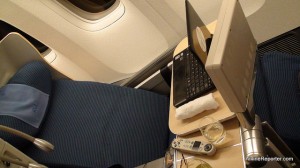
Lots of room to work, sleep and play in ANA's Business Class. Click for larger.
From the lounge I could see when my ANA Boeing 777-300ER arrived and I headed down to the gate. This is where I had another bonus: being able to board first. The Boeing 777 I flew had First Class, quite a bit of Business Class, Premium Economy and then of course standard economy. Getting on the plane first to get settled for a 11hr flight is always nice.
Where most airlines have a rule that you can still use your electronic devices until they close the cabin door, ANA is much more strict. When I first walked into the plane I was told I had to shut off my phone. I then I tried to take some photos, but was politely told I couldn’t have my camera on either until we reached 10,000 feet. Eh, lame, but what can I do?
The seats were very spacious; there was 63″ of seat pitch and 21″ of width. There were only 7 seats across in a 2-3-2 configuration and of course I went for a window seat (photo). Unfortunately my original seat was 11A which had a dead space with only one window. Luckily, after the plane boarded, I was able to move back to 12A with all my windows. This was important since the flight was leaving at about 1pm and we would be racing the sun all the way to Japan — meaning it was going to stay light the whole flight.
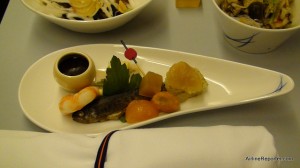
One of three appitizers for one of my three course meals. Yes that is a whole fish you see (and I ate it).
After take off the flight attendants came around asking what we would like for our first meal. Boy did we have good choices: two Japanese meals and one Western-style. I didn’t know what half the food was, but I went for seared bass (photo) and whatever else came with the Japanese meal. There was a lot, a whole three courses worth of food. The food was fabulous and not like airline-food fabulous, but actual food in a nice restaurant fabulous.
While eating, it was time to start watching the in-flight entertainment. Each person has their own screen that folds out of the seat with a handy controller. There were quite a few pre-programmed movies and shows which are all free (even in economy), but I think the entertainment option was a weak spot for ANA. In the long run getting satellite internet and live TV would be great, but ANA did work with Boeing’s Connexion that provided satellite internet, but that didn’t work out. I am hoping in the future ANA and more international airlines will be adding internet and live TV. For the short term maybe a few more movie and television choices would have been nice. After flying 22hrs in total (there and back) I was quite done with my movie selections and I was NOT about to watch Sex and the City 1 and 2.
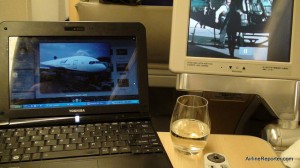
Flying, blogging, drinking and watching a movie. What else do I need? (anyone guess that movie?).
The seats were very comfortable and were quite adjustable (photo). They don’t lie totally flat, but they came pretty darn close. Talking to folks who are a bit shorter (I am 6’1″), some said they have had issues sliding down on the seat, but I did not. I was actually able to fit on the seat comfortably and got some real sleep on both flights.
Not only was the product very good, but the service was wonderful as well. They would constantly check up on me and always had a smile. The flight attendant’s faces must have hurt after smiling so bit, non-stop for the entire 11 hour flight.
Although ANA’s “old” Business Class product I tried out was quite good, they are introducing a newer and better pod-style Business Class on their new Boeing 777-300ER’s.
All this great product and service comes at a price. A Business Class Seat on ANA from LAX to NRT can cost $4000.00 plus. Of course many folks flying in Business Class either have a corporate credit card paying or are using their miles. If the Business Class isn’t enough for you, ANA’s also has First Class on many of their international flights which is a whole other experience. No matter what class I am in, I am always excited to take a flight halfway around the world.
MORE PHOTOS OF THE FLIGHT
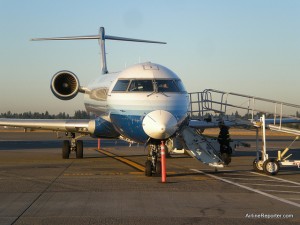
United Express CRJ-700 on the tarmac at Seattle
This flight was something special for me. My first CRJ-700 flight ever and my first United Express flight in quite some time. As I just discussed recently, even though my plane might have “United” on the side, the flight is actually operated by SkyWest under the “United Express” brand.
My flight left early…7am. That meant getting up before I think people should be awake and heading to the airport. At least it was a beautiful morning and I was able to capture a few shots of my CRJ-700 on the tarmac with the moon behind it. One of the gate agents was so taken with the moon she made an unusual announcement letting passengers know they should check out the moon and many passengers flocked to the window. It was kind of cool to see that level of interaction.
United recently started being more aggressive selling upgrades to customers. I didn’t get around to checking in at home, so I did so at the airport. I was asked if I wanted to pay an extra $29 for Economy Plus, which gives you a few inches of extra leg room, you sit at the front of the plane and you get to board earlier. I didn’t feel the need to pony up the $29.00 extra for the 2.5hr flight. Since the flight was overbooked, I had to get my seat assignment at the gate. Lucky for me I got seat 6D, which was Economy Plus and I didn’t have to pay. Due to the overbooking, United was offering $400 travel vouchers which went fast. Everyone who wanted to fly was able to fly.
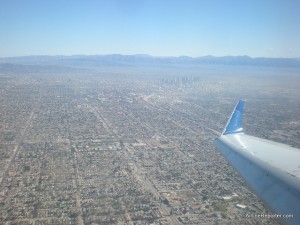
LA was pretty smog free on this flight...nice!
Before boarding a gate agent came on the intercom and apologized they had no jetway for the flight and we would have to board on the tarmac. Ha! No one should ever have to apologize for boarding on the tarmac. Okay, maybe the average passenger might not like going down the stairs or dealing with bad weather (United does provide umbrellas), but to me it is always worth it. Being down with the plane and boarding on the tarmac is always a welcomed experience.
The take off on the CRJ-700 was amazingly smooth. There wasn’t the big jolt you get with most other airliners. Many pilots I have talked to, see the CRJ-700 as a hotrod. Improved wings and engines over the CRJ-200 make the CRJ-700 a nimble and quick aircraft. It is able to take off quickly, while cruising at Mach 0.78.
Going to the rear of the aircraft was an interesting adventure. Unfortunately when I got up, the sign said no one was in the lavatory, but by the time I got there someone snuck in. Unlike larger aircraft there is no where to stand in the back of the CRJ-700. There is only the last row of seats and then, BAM the bathroom. So, when waiting you are standing in the aisle right next to seats with either your butt, crotch or thigh in their face. Akward for me and has to be annoying for the people in the back. When the passenger came out of the restroom, it was difficult to let them pass me without bumping into the passengers in the back row.
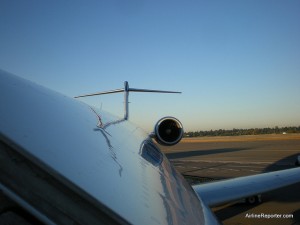
I love boarding on the tarmac!
The rear of the plane is also quite a bit louder. With the combination of the increased sound, not being able to recline your seats and people standing/walking past you to use the restroom, I suggest avoiding sitting in the back if you can. It would surely be worth the $29 to get Economy Plus versus having to sit in the back row.
The flight down to LAX was beautiful and clear, making the scenery a real treat. I only wish it was easier to see out my window in seat 6D. The CRJ-700 has windows pretty spaced out, as you find more with regional jets versus larger airliners. Some seats end up perfectly aligned and others, like 6D, end up in an odd position. On my flight back home I got seat 10D, which is not Economy Plus, but my window was perfect. Even at 6’1″, I would rather have a lined up window than extra leg room, but I know most passengers probably don’t feel the same way.
Even with the hindered view, having the extra leg room on the flight to LAX was nice. On both flights I worked on my laptop (actually writing up this blog) and it was much easier with the extra room (I have a gut that gets in my way, as well). Even with the person in front of me in Economy Plus reclined, I had no problems with my laptop being fully open, but it wasn’t the same in standard seating.
From my own personal experiences and reading those of others, I often have a lower expectation level for regional airlines. I was quite happy with the service, friendliness and professionalism from all four SkyWest flight attendants working the United Express flights.
Even though the plane might be a bit smaller and have a few draw backs (ie don’t sit in the back and go to the restroom before flying), the positives outweigh the negatives. Running smaller aircraft, like the CRJ-700, allows airlines to provide more daily flights and in more cases at a cheaper fare. Getting on and off the plane is much quicker than a larger Boeing 737 or Airbus A320 and if you are an airline nerd (which you might be reading this), you have a greater chance to board on the tarmac.
MORE PHOTOS
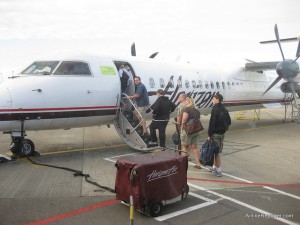
Me about to board the Q400 in Seattle. I should have waved, presidential-style.
I have flown the route from Seattle to Reno many times in my life. From Reno Air back in the day, to Southwest, to America West to Alaska Airlines. The flight is easy, only about 1.5hrs, enough time to take off, get a drink and snacks and start the descent. In April 2008 Horizon Air took over the route for Alaska and since then, they have been the cheapest to fly. I actually prefer the flight on Horizon’s Q400’s versus Alaska’s Boeing 737 (or MD-80’s back in the day).
The main reason is, I love flying in smaller planes. It really lets the passenger connect with the flying experience. I think a lot of people do not like flying on smaller planes just for this reason. Unlike the larger planes, you get to board on the tarmac, which allows you to see the entire plane, not just a few inches around the door when you board in a jetway. The inside of the Q400 is set up in a 2-2 layout, so you always get a window or aisle. Of course I always go for the window, but I am happy to know if I don’t get one, I won’t be stuck in the middle.
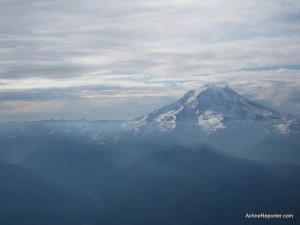
Mount Rainier, just outside of Seattle, was one of many mountains you can see on the Seattle to Reno flight.
On this trip I was in a group of four people, which allowed me to get a few photos of me with the plane and even better photos from both sides of the plane while flying. The flight from Seattle to Reno is beautiful. From Mount Rainier to Crater Lake, if it isn’t cloudy, you are in for a real treat. The Q400’s fly quite a bit lower at about 25,000 feet versus 30,000 to 40,000 with larger aircraft and their wings are high, which means everyone has an awesome view.
We all checked in the day before online and only had carry-ons, so we didn’t have to wait in any Horizon lines, just put up with the security ones. Horizon has a semi-hybrid option between carry-on and checking your bags, called Ala Cart. Since the overhead bins are smaller than you would find on larger aircraft, not all carry-ons can fit in them. If yours cannot fit or you don’t want to lug it on the plane you can put your carry-on on a cart while boarding. They will put it on another cart when you arrive at your destination. It’s way quicker than having to wait in baggage claim not to mention, the Ala Cart option is free. If you do need to check your bag, it will cost you $20 per bag, up to 3 bags. Like their sister carrier, Alaska Airlines, Horizon also provides the 20 minute checked baggage guarantee.
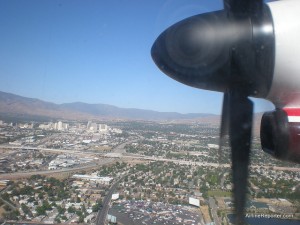
Beautiful downtown Reno, just about to land.
Talking about Alaska Airlines, Horizon’s relationship with them is quite unique. Some people think of Horizon as Alaska’s regional carrier, but they are set up very differently. Both airlines have a parent company, Alaska Air Group which owns and manages both airlines. Most regionals fly for a larger airlines for fees and Horizon will sometimes fly for Alaska, but they mostly fly under their own brand. Horizon has their own marketing department, their own ads and unique brand of service. You will see the two airlines share a website together, but both logos are prominently displayed.
One thing that does make Horizon unique is offering free, regional wines and micro-brews, ah yea…can’t miss out on this. Our flight left at 7:40am, but that didn’t stop us from trying out some of that free local wine and beer. I mean, come-on it was the blog right?! Horizon is also offering free snack-packs on their Seattle to Portland flight, but I have yet been able to experience that first hand.
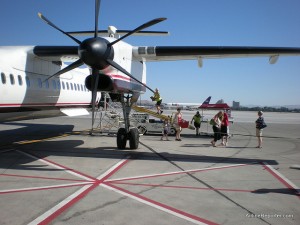
Passengers were able to de-board from the front and back of the Q400, making it super quick. Employees are getting the Ala Cart bags out.
A passenger in our group (we shall call her “Rita”) was a little apprehensive about flying on a smaller aircraft. I know many others out there have that same fear. However, I quickly pointed out that Horizon Air is extremely safe and has never had a fatality since they started flying in 1981 and haven’t had any sort of incident since 1990. That made Rita feel much more comfortable and after the flight she very much loved her Horizon experience (maybe the glass of wine she had at 8am helped too).
The Horizon Q400’s might be a bit slower than jet airliners, but they are much more cost effective and friendly for the environment. Horizon has green stickers on each of their planes touting how green they are and even painted one of their Q400’s entirely green (can you see “Shrek” as they call it here or here?)
I definitely get excited to fly on Horizon and flying on the Q400’s and hope that some of you can feel a bit more at ease flying in smaller planes in the future.
Check out my (ok our, thanks Ben, Rita and Amy) additional pictures of the trip.
UPDATE: I have been informed there are two green Q400’s, nicknamed “Shrek” and “Fiona.”
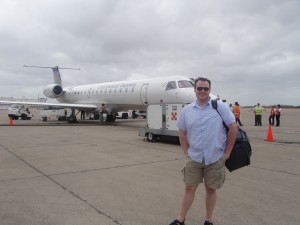
Me in front of the first ERJ-145 I flew after landing at Mazatlan Airport. I love being able to get close to the plane on the tarmac.
I am currently about 37,000 feet on a Continental Express ERJ-145. I am heading from Mazatlan, Mexico (MZT) to Houston, TX (IAH), then on to my home in Seattle (SEA) [which will be on a Boeing 757]. Well, sort of…right now, as I write this blog, it is the morning of Saturday May 8th. My flight does not have wi-fi, but I am writing it in notepad and will post it up on Monday the 10th. Every time I am in the air, I always try to write up at least a few blogs, since I love the inspiration.
This is my second flight in a regional jet, my first being a week ago heading from IAH to MZT. It is quite amazing, with all my flying experience I have not flown on a ERJ-145. My home base is in Seattle and there just aren’t many flights with regional jets to and from SEA.
When booking my flight, I purposely choose Continental since I would be able to fly on an ERJ-145 (I know, I have heard the “airline nerd” jokes already). I have heard some positive, but mostly negative things about flying the aircraft and I was excited to check it out myself.
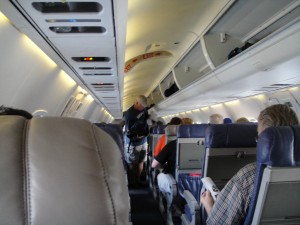
The 1-2 layout is nice, but small overhead-bins are only on one side.
There are a lot of people out there that do not like flying in smaller planes. They will go out of their way and pay more to avoid them. Yes, the ride can be more bumpy, there are normally less experienced pilots flying them, and it can be a tight fit. However, I think the positives out weigh the negatives.
For me, the smaller the aircraft let me feel more connected to the flying experience. I understand that some people like to forget they are in a man-made machine 37,000 feet above the ground, but not me.
I enjoy the 1-2 seat layout. There is a single seat on the left side of the plane and two seats on the right side of the plane. This means that every person either has a window or aisle seat. On both flights I sat on the single seat side. It is nice being able to see out the window and have easy access to the aisle.
The seats feel quite roomy and the ERJ-145 has 17.3″ width and 31″ pitch, which isn’t bad. The Boeing 737-800 I flew from SEA to IAH also had 31″ pitch and only 17.2″ width.
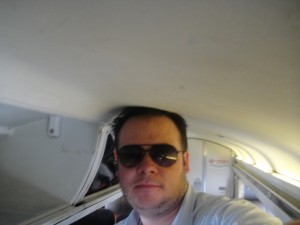
Don't make fun of my hecka-awesome shades or my man-beard. Headroom wasn't so great for being 6'1".
The ERJ-145 only holds 50 passengers, which gives it an intimate experience. I seems easier to talk to other passengers and get to know those around me. Since there are less passengers, the turn around time of the aircraft is very short (time from landing to being able to take off again). This allows airlines to provide more flight options to destinations and more flights to smaller airports.
There are a few downsides to the ERJ-145. I am currently sitting in row 17 of 19 rows. The only lavatory is located at the back of the aircraft. It seems not many people went to the restroom before taking off, since a lot of folks have made a visit back here. I could see where this would be distracting for someone wanting to sleep.
There is also very limited carry-on room. If you are trying to bring on bigger carry-ons, be prepared to have them checked. Out of the five of us travelling in my group, only two were able to bring their carry-ons aboard (and we were able to take all of them on board the Boeing 737 from SEA to IAH).
I have heard people talk about service on smaller regional aircraft can be sub-par. Even though I have experienced great service on some smaller airlines, like Horizon Air (the free beer or wine helps), I have personally seen a lower level of service when flying regional aircraft. Although I did get a free snack (this will be short lived), the flight attendants, both to and from MZT, definitely were not friendly and were quite rude to passengers. It could have just been a coincidence, but it was noticeable.
My flights to and from MZT were Continental Express, which is run by ExpressJet, however, the Continental name is on the airplane and on my ticket. I strongly feel that is a larger airline is willing to put their name on a regional airline, they are partly responsible for the quality of service one receives. Passengers should have a consistent level of service no matter what kind of aircraft they are flying.
The ERJ-145 is built by Embraer, an airplane manufacture based out of Brazil. The aircraft first flew in August 1995 and started service with airlines in 1996. To date over 1,100 ERJ’s have been manufactured. With so many ERJ-145’s out there and many more on order, I have a feeling this won’t be my last experience with this aircraft type.
Find a few more pics via my Flickr account.
connect | web | twitter | facebook |













